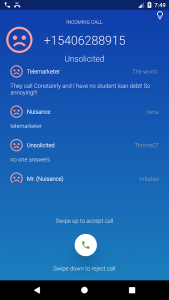 Unwanted marketing calls, annoying phone pranks or even dangerous phone scam. Nowadays, it all often starts with “spoofed numbers” – a tactic of changing the phone number you see on a display of your phone. And, surprisingly, it’s not illegal.
Unwanted marketing calls, annoying phone pranks or even dangerous phone scam. Nowadays, it all often starts with “spoofed numbers” – a tactic of changing the phone number you see on a display of your phone. And, surprisingly, it’s not illegal.
Picture this: you receive a phone call from a caller who (according to your caller ID) appears to live in the same neighborhood as you do. It looks familiar, so you answer it – but then realize that, in fact, it’s just another marketing call.
What happened? You just became a victim of the so called “number spoofing” (faking the number that appears on your caller ID). Lately, it’s been very popular tactics how to push you to answer a call.
In this post, we cover:
- How to recognize spoofed numbers?
- Most popular tactics connected to spoofing
- How to protect yourself against spoofing?
Spoofed numbers: it’s not difficult. And it’s not illegal, either
A “spoofed” number is usually just a beginning (and yes, you should be lucky, if you get “only” pranked because of it – otherwise the consequences can be much worse, as we will describe later). And, surprisingly, spoofing a number isn’t very difficult at all.
 In the past, phone hackers trying to mask a phone number behind someone else’s used so called “orange boxes”, a fairly complex hardware. Nowadays it’s different. And much easier as well. Literally anybody can use simple solutions like a mobile app, which allows users to mask their real phone number (in exchange for credits).
In the past, phone hackers trying to mask a phone number behind someone else’s used so called “orange boxes”, a fairly complex hardware. Nowadays it’s different. And much easier as well. Literally anybody can use simple solutions like a mobile app, which allows users to mask their real phone number (in exchange for credits).
And, surprisingly again, it isn’t necessarily illegal in the US. The Federal Communication Commition only prohibits someone from using a misleading caller ID number if their intent is to defraud, cause harm or obtain anything of value. That means someone who wants to just maintain own privacy or perform a prank call to a friend would be safe in the eyes of law.
–> Spoofed numbers: why isn’t it illegal? There’s at least one reason
Beware of these popular, but dangerous tactics
But here’s the fact. “Spoofed” numbers are often used to no good. Here are the most often used (and real) scenarios:
1. Hacking your online accounts
In this popular tactics, spoofing the call number is just step one in a dangerous social engineering play. Imagine this: your partner or child is calling (as you can clearly see on your phone display), desperate because of forgotten password to your bank account. Honestly: what will you do?
2. One ring phone scam
Usually it goes like this. Your phone rings once and then stops. And then, if you’re not careful enough, you call back – and just by calling, you lost a lot of money. How’s that? Even though the number that appears in your phone log as a missed call appears to be a U.S area code, it’s actually a three-digit international area code. If you return the call, you could be connected to a phone number outside the United States, often in Canada or the Caribbean, and charged expensive international call rates.
–> Read more about one ring phone scam
3. … and other scam tactics
Spoofing a number is an incredible tool for scammers in general. Thanks to this feature, they can fake anything: that they are your Microsoft support, teacher from your children’s school… whatever they want.
4. Telemarketing
Well, it does make a sense. We are more willing to answer phone calls that appear to come from our neighborhood – and telemarketers know that.
5. Pranks (even the dangerous ones)
The “spoofed number” tactic has been used in the past by “swatters” who called police to report hostage crisis hoaxes, so armed police respond at an unsuspecting victim’s door.
How to protect yourself?
 Let’s say this clear. Unfortunately, there is nothing such as an ultimate protection against spoofed numbers. But there are a few tactics that can help you to stay (relatively) safe.
Let’s say this clear. Unfortunately, there is nothing such as an ultimate protection against spoofed numbers. But there are a few tactics that can help you to stay (relatively) safe.
First of all: don’t ever put all your trust in the Caller ID information presented to you. Now that you know that this information is easily spoofed by the use of 3rd party Caller ID spoofing services and other tools, you won’t be as trusting in the technology as you have been. Right?
And, luckily, there are some other methods how to fight spoofed numbers as well. A helpful assistant can be an app that can block unwanted or negative phone calls. If you want to try it, get the Should I Answer app – it’s based on daily updated database of number’s reviews based on real experience, and because scammers (who are hiding behind spoofed number) often use just a few fake numbers, the Should I Answer can recognize them and warn you against them (or block them completely).